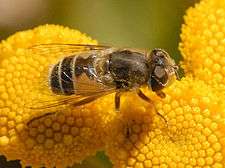Eristalis abusiva
| Eristalis abusiva | |
|---|---|
 | |
| male | |
 | |
| female | |
| Scientific classification | |
| Kingdom: | Animalia |
| Phylum: | Arthropoda |
| Class: | Insecta |
| Order: | Diptera |
| Family: | Syrphidae |
| Genus: | Eristalis |
| Subgenus: | Eoseristalis |
| Species: | E. abusiva |
| Binomial name | |
| Eristalis abusiva Collin, 1931 | |
Eristalis abusiva is a European species of hoverfly. it is similar to Eristalis arbustorum.[1]
Description
External images
For terms see Morphology of Diptera
Wing length 8-9·5 mm.
Shiny scutellum.Face covered with pale dust (a narrow black stripe in worn specimens) on lower part. Arista with the apical half bare and basal half very short-haired.Eyes pale yellow haired.Male eyes separated.Tibia pale black on basal 1/4 or less.Tibia 2 very pale.
[2]
[3]
[4]
[5]
The male genitalia are figured by Hippa et al. (2001) [6] The larva is figured by Hartley (1961) [7]
Distribution
Palaearctic Fennoscandia and the Faroes (Jensen, 2001) south to North France.Ireland eastwards through North Europe and Central Europe then East into Russia and the Russian Far East and Siberia to the Pacific coast. [8] [9]
Biology
The habitat is wetland, coastal fen and salt-marsh, marsh and fen, raised bog and cutover bog.[10] Flowers visited include yellow composites, white umbellifers, Calluna vulgaris, Caltha, Cirsium, Erica, Potentilla erecta, Ranunculus, Rubus fruticosus, Salix repens, Stellaria, Spartina.[11] The flight period is beginning May to mid October.The larva is aquatic.
References
- ↑ Van Veen, M.P. (2004). Hoverflies of Northwest Europe, Identification Keys to the Syrphidae (Hardback). Utrecht: KNNV Publishing. p. 254. ISBN 90-5011-199-8.
- ↑ Stubbs, Alan E.; Falk, Steven J. (1983). British Hoverflies: An Illustrated Identification Guide. British Entomological and Natural History Society. pp. 253, xvpp.
- ↑ Van der Goot,V.S. (1981) De zweefvliegen van Noordwest - Europa en Europees Rusland, in het bijzonder van de Benelux. KNNV, Uitgave no.32: 275pp. Amsterdam.
- ↑ Bei-Bienko, G.Y. & Steyskal, G.C. (1988) Keys to the Insects of the European Part of the USSR, Volume V: Diptera and Siphonaptera, Part I. Amerind Publishing Co., New Delhi. ISBN 81-205-0080-6.
- ↑ Coe, R.L. (1953) Diptera: Syrphidae. Handbks.ident.Br.insects, 10(1): 1-98. R.ent.Soc.London. pdf
- ↑ Hippa, H., Nielsen, T.R. & van Steenis, J. (2001) The west Palaearctic species of the genus Eristalis Latreille (Diptera, Surphidae). Norw.J.Entomol., 48: 289-327.
- ↑ Hartley, J.C. (1961) A taxonomic account of the larvae of some British Syrphidae. Proc.zool.Soc.Lond.,136: 505-573.
- ↑ Fauna Europaea
- ↑ Peck, L.V. (1988) Syrphidae. In: Soos, A. & Papp, L. (eds.) Catalogue of Palaearctic Diptera, 8: 11-230. Akad.Kiado, Budapest.
- ↑ Speight, M.C.D. (2011). "Species accounts of European Syrphidae (Diptera)" (PDF). Syrph the Net, the database of European Syrphidae. 65: 285pp.
- ↑ de Buck, N. (1990) Bloembezoek en bestuivingsecologie van Zweefvliegen (Diptera, Syrphidae) in het bijzonder voor België. Doc.Trav. IRSNB, no.60, 1-167.
| Wikimedia Commons has media related to Eristalis abusiva. |